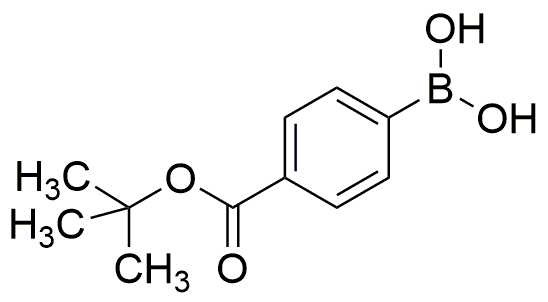4-(tert-Butoxycarbonyl)phenylboronic acid is widely utilized in research focused on:
- Organic Synthesis: This compound serves as a key intermediate in the synthesis of various organic molecules, particularly in the development of pharmaceuticals and agrochemicals, allowing for the creation of complex structures with high efficiency.
- Cross-Coupling Reactions: It is commonly used in Suzuki-Miyaura cross-coupling reactions, which are essential for forming carbon-carbon bonds. This application is crucial in the production of fine chemicals and advanced materials.
- Drug Development: The compound plays a significant role in medicinal chemistry, aiding researchers in the design and synthesis of new drug candidates, particularly those targeting specific biological pathways.
- Bioconjugation: It is utilized in bioconjugation techniques, where it helps attach biomolecules to surfaces or other molecules, enhancing the development of targeted therapies and diagnostic tools.
- Material Science: The compound is also applied in the creation of functional materials, such as sensors and catalysts, benefiting industries focused on innovation in nanotechnology and materials engineering.
General Information
Properties
Safety and Regulations
Applications
4-(tert-Butoxycarbonyl)phenylboronic acid is widely utilized in research focused on:
- Organic Synthesis: This compound serves as a key intermediate in the synthesis of various organic molecules, particularly in the development of pharmaceuticals and agrochemicals, allowing for the creation of complex structures with high efficiency.
- Cross-Coupling Reactions: It is commonly used in Suzuki-Miyaura cross-coupling reactions, which are essential for forming carbon-carbon bonds. This application is crucial in the production of fine chemicals and advanced materials.
- Drug Development: The compound plays a significant role in medicinal chemistry, aiding researchers in the design and synthesis of new drug candidates, particularly those targeting specific biological pathways.
- Bioconjugation: It is utilized in bioconjugation techniques, where it helps attach biomolecules to surfaces or other molecules, enhancing the development of targeted therapies and diagnostic tools.
- Material Science: The compound is also applied in the creation of functional materials, such as sensors and catalysts, benefiting industries focused on innovation in nanotechnology and materials engineering.
Documents
Safety Data Sheets (SDS)
The SDS provides comprehensive safety information on handling, storage, and disposal of the product.
Product Specification (PS)
The PS provides a comprehensive breakdown of the product’s properties, including chemical composition, physical state, purity, and storage requirements. It also details acceptable quality ranges and the product's intended applications.
Certificates of Analysis (COA)
Search for Certificates of Analysis (COA) by entering the products Lot Number. Lot and Batch Numbers can be found on a product’s label following the words ‘Lot’ or ‘Batch’.
Numéro de catalogue
Numéro de lot/série
Certificates Of Origin (COO)
This COO confirms the country where the product was manufactured, and also details the materials and components used in it and whether it is derived from natural, synthetic, or other specific sources. This certificate may be required for customs, trade, and regulatory compliance.
Numéro de catalogue
Numéro de lot/série
Safety Data Sheets (SDS)
The SDS provides comprehensive safety information on handling, storage, and disposal of the product.
DownloadProduct Specification (PS)
The PS provides a comprehensive breakdown of the product’s properties, including chemical composition, physical state, purity, and storage requirements. It also details acceptable quality ranges and the product's intended applications.
DownloadCertificates of Analysis (COA)
Search for Certificates of Analysis (COA) by entering the products Lot Number. Lot and Batch Numbers can be found on a product’s label following the words ‘Lot’ or ‘Batch’.
Numéro de catalogue
Numéro de lot/série
Certificates Of Origin (COO)
This COO confirms the country where the product was manufactured, and also details the materials and components used in it and whether it is derived from natural, synthetic, or other specific sources. This certificate may be required for customs, trade, and regulatory compliance.


